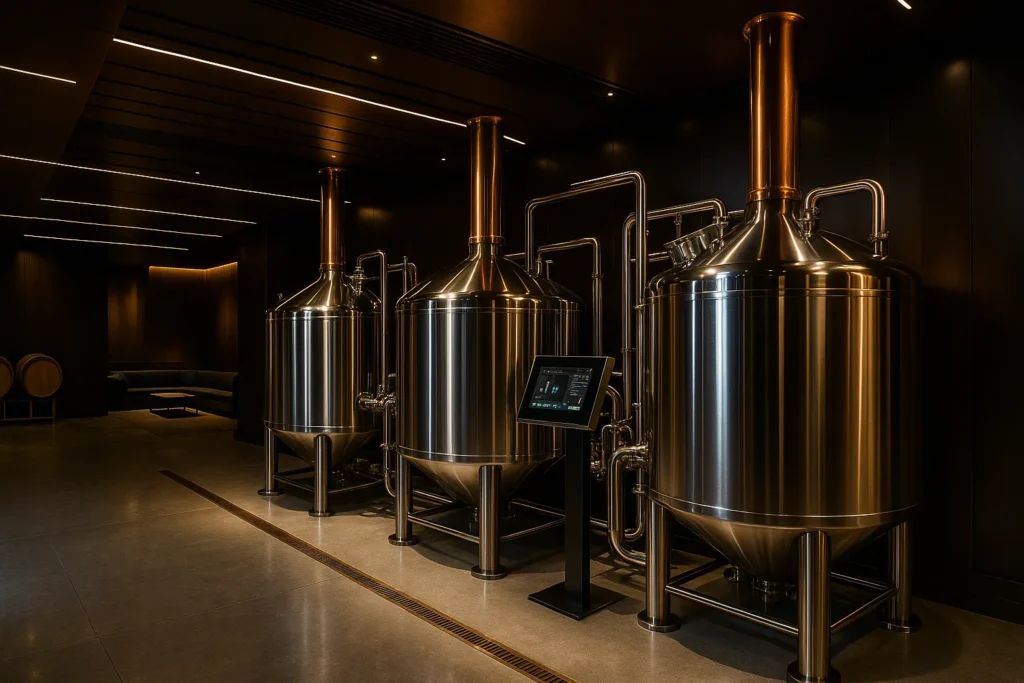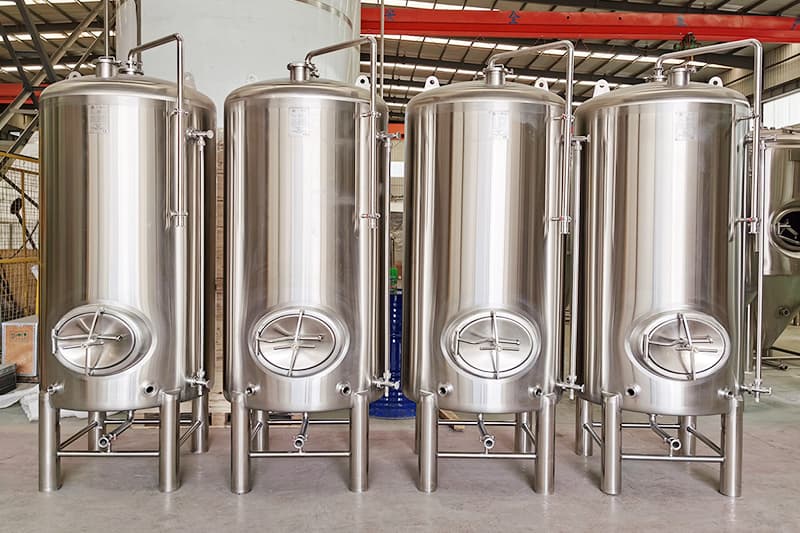Small breweries often struggle with inconsistent batches and rising energy bills. Without high quality brewing equipment, each batch of beer becomes a risky experiment. Our customizable, stainless steel brewing systems bring rock‑solid consistency, letting you focus on the craft, not the chaos.
Modern brewing equipment combines a precision‑engineered brewhouse, jacket‑cooled fermenters, efficient pumps, and a glycol chiller. Together, they stabilize temperatures, shorten brew days, and boost yield. Breweries that adopt an integrated system cut losses by up to 12 % and recoup ROI in under 24 months.

1. What Makes a Brewhouse the Heart of Your Brewery?
A brewhouse is more than shiny metal—it’s the engine room where every future pint is born.
The brewhouses blends grain, heat, and water to create wort—the sugary fuel that powers yeast. Our 2‑ to 60‑bbl systems marry motorized rakes with steam‑jacketed kettles, giving you mash uniformity, faster lautering, and higher gravity targets. By recirculating wort through a variable‑speed pump, brewers routinely hit 86 % mash efficiency, trimming grain costs batch after batch.
For operations seeking compact efficiency, check out our 2‑vessel brewhouse solution—ideal for pubs that want shorter brew days without sacrificing flexibility.
“Switching from a hobby set‑up to a semi‑automatic 15 BBL brewhouse let us brew double‑IPAs without stuck sparges.” — River Bend Craft Brewers
Smart brewhouse data flows to your control panel, archiving temperatures, pressures, and flow rates for regulatory reports. Knowing your numbers is knowing your beer. Next, let’s size that system so it fits your growth curve.
2. How Many BBLs Should Your Brewing System Handle?
Capacity planning begins with an honest look at today’s taproom crowds—and tomorrow’s wholesale dreams.
Choosing the right size balances cash flow, fermentation space, and future expansion. Start‑ups often launch on 3 BBL skids, brewing one batch of beer a day to keep five core taps fresh. At 7 BBL, a brewpub can dedicate seasonal taps and still finish by dinner service. Regional players step to 20 BBL, pairing double‑brews with night‑shift cellar transfers for 10 000 hl a year.
Curious what a full‑scale package looks like? Explore our turnkey 60 BBL brewing system designed for regional distribution growth.
Break‑Even Snapshot
| System | Annual HL | CapEx (USD) | Avg. ROI |
|---|---|---|---|
| 3 BBL | 350 | 45 000 | 18 mo |
| 7 BBL | 1 000 | 92 000 | 20 mo |
| 20 BBL | 10 000 | 350 000 | 26 mo |
Armed with your volume target, let’s pick the ideal kettle material.
3. Stainless Steel Kettles vs. Copper: Which One Delivers Quality Beer?
Looks inspire drinkers; cleanliness inspires accountants.
Copper’s warm glow charms taproom tours, yet stainless steel wins every measurable test—sanitation, durability, and automation readiness. Tri‑clamp connections seal tighter; orbital welds resist caustic. Breweries that swap to stainless report 22 % lower upkeep and one‑third shorter cip cycles.
For small‑scale innovators, our compact nano brewery equipment line delivers stainless performance without copper’s upkeep costs.

Why stainless kettles improve your brewing offers deeper case data. With a sanitized hot side in place, we move downstream to the cold side—the fermenters.
4. Fermenter Design Essentials: Jacket Cooling, Glycol Loops & Sanitary Welds
Fermentation is where wort transforms into personality.
Our conical unitank line features dual‑zone dimple jackets matched to BTU specs from a dedicated glycol chiller. Tanks range 3 hl to 100 hl, each bead‑blasted inside to 0.4 μm Ra. A 60 ° cone angle channels trub toward an oversized drain valve, accelerating CIP.
See construction details on our flagship beer fermenter tanks, engineered for pressure fermentation and spunding.
Temperature precision is non‑negotiable. A twin‑stage glycol loop holds ±0.2 °C—tight enough to guard ester profiles in Belgian saison yet cool lager ferments to 10 °C. Next, let’s see how your energy source frames operating budgets.
5. Can Electric Brewing Reduce Your Operating Costs?
Electricity can be your silent partner—if the math checks out.
Electric elements achieve >95 % conversion, trimming utility bills. Paired with PID, you can program precise step‑mash rests hands‑free. Breweries in high‑tariff steam districts often recoup electric panels in 14 months.
Looking to automate further? Our electric beer brewing system delivers industrial throughput without gas lines.
“After switching to electric, we cut brew‑day noise in half—making tours more enjoyable.” — Beacon Hill Brewery
With energy dialed in, we move to the cellar logistics that keep beer flowing on schedule.
6. Building an Efficient Cellar: Pumps, HLTs, and Brite Tanks Explained
Good beer ages in silence; great beer moves through organized stainless pathways.
An organized cellar cuts transfer losses:
- Pump—variable‑frequency, food‑grade impeller.
- HLT—steam coil pre‑heats strike water, reclaiming 15 % energy.
- Brite tanks—double‑walled, less than 2 ppm O₂ pickup. View our 20 BBL bright beer tank for packaging‑ready clarity.

Short hose runs matter. Every extra 50 ft means nearly one gallon of wort left behind. But what if you’re brewing inside a shipping container or garage? Let’s shrink the footprint.
7. All‑in‑One Nano Systems: Brewing One Batch of Beer at a Time
Space constraints shouldn’t cap creativity.
Our all‑in‑one nano skids integrate brew kettle, whirlpool, and conical fermenter on a 1.8 × 1.2 m frame. Quick‑disconnect casters let you roll the brewhouse aside when cleaning floors or hosting events. Plug‑N‑brew wiring runs on 240 V single‑phase—ideal for lease‑hold locations where 3‑phase is impossible.
Case in point: Oak & Ivy Kombucha started with 100 L, hit retail shelves in eight months, then bolted a second fermenter inline, doubling output without new premises. The semi‑automatic package includes:
- Wi‑Fi control panel with recipe recall
- Weldless sight‑glass for rapid gravity checks
- Integrated plate heat exchanger cooled via 100 L ice‑bath for off‑grid sites
Nano today, regional tomorrow. Keeping growth sanitary demands a rock‑solid cleaning regime.
8. Process Piping & CIP: How to Keep the Brewing Process Clean
Cleanliness is next to beerliness.
Our orbital‑polished pipes form a hermetic seal with EPDM gaskets. Automated cip cycles blast 360 ° jets, turning 2 h of elbow‑grease into a 45‑minute push‑button routine. A swing‑arm recirculation loop cleans both brewhouse and cellar in a single pass, saving 500 L of caustic per week on a 15 BBL line.
CIP Quick‑Cycle
| Step | Temp (°C) | Flow (L/min) | Time |
|---|---|---|---|
| Caustic | 80 | 120 | 20 min |
| Rinse | 25 | 120 | 10 min |
| Acid | 65 | 100 | 10 min |
| Final | 15 | 120 | 5 min |
Read our CIP best practices guide. With hygiene locked, let’s map the journey from hobbyist to production.
9. Scaling From Home Brewing Kit to 30 BBL Production—Step‑by‑Step
Every regional powerhouse started with a single carboy.
- Home brewing → 1 BBL pilot skid for recipe R&D.
- Add a 3‑BBL mash tun and double‑length brew kettle to hit small wholesale.
- Install a 10 BBL frame; upgrade glycol to 7.5 tons.
- Expand the cellar with stacked 20 BBL fermenters and jacketed brite tanks.
- Integrate semi‑automatic keg washer, inline bottle filler, and capping turret.
- Retrofit racking manifold for beer‑line purge and keg couplers.
Investment & Timeframe
| Stage | CapEx (USD) | Timeline |
|---|---|---|
| Pilot 1 BBL | 25 000 | 3 mo |
| 10 BBL Expansion | 140 000 | 6 mo |
| 30 BBL Buildout | 320 000 | 8 mo |
Ask about finance partners specializing in brewing‑equipment leasing. Finally, let’s see why global service matters.
10. Global Support & Customization: Why Partner With Our Manufacturing Plant?
Equipment is only half the story—support writes the epilogue.
We are a Chinese brewing equipment manufacturing plant serving 40+ countries. From North Dakota nano startups to Lisbon kombucha hubs, customers value:
- OEM & ODM geometry tweaks for local codes
- On‑site commissioning and process piping layout
- 24/7 diagnostics via VPN
- Spare‑parts stocking on three continents
“Their after‑sales team solved a pump seal failure within 12 hours. Downtime? Zero.” — Stone Harbor Distilling
Ready to design? Start with our complete beer brewing equipment portal and request a tailored quote today.
FAQs
How long does it take to install a 10 BBL brewhouse?
Typical on‑site build plus testing runs 10–14 days, including control‑panel calibration and staff training.
Do I need a glycol chiller for small batches?
Yes. Even one batch benefits from modest cooling to control fermentation temperature—especially over summer.
What sanitary certifications do your welds meet?
All welds follow ASME BPE food‑grade standards and are X‑ray tested at 10 % sample rate.
Can I brew cider or mead on the same system?
Absolutely. Dedicated CIP loops and separate hose kits prevent cross‑flavor contamination.
Is a spunding valve necessary for every tank?
For pressure‑fermented lagers or CO₂ recovery, yes—it preserves carbonation and trims diacetyl rests.
How do I finance a complete all‑grain line?
We partner with global leasing firms; terms average five years with flexible buy‑outs, ideal for craft brewers scaling quickly.
Key Takeaways
- Integrated brewhouse + cellar delivers consistent, scalable output
- Stainless steel construction with sanitary welds meets food‑grade rules worldwide
- Correct glycol sizing safeguards every batch from temperature swings
- Modular design means you expand from nano to 60 BBL with minimal downtime
- A full‑service manufacturing plant guarantees design, install, and lifetime support—so you can keep crafting unforgettable beer
